ASRock FM2A88X Extreme6+ Review
by Ian Cutress on March 19, 2014 11:59 AM ESTReal World CPU Benchmarks
Readers of our motherboard review section will have noted the trend in modern motherboards to implement a form of MultiCore Enhancement / Acceleration / Turbo (read our report here) on their motherboards. This does several things – better benchmark results at stock settings (not entirely needed if overclocking is an end-user goal), at the expense of heat and temperature, but also gives in essence an automatic overclock which may be against what the user wants. Our testing methodology is ‘out-of-the-box’, with the latest public BIOS installed and XMP enabled, and thus subject to the whims of this feature. It is ultimately up to the motherboard manufacturer to take this risk – and manufacturers taking risks in the setup is something they do on every product (think C-state settings, USB priority, DPC Latency / monitoring priority, memory subtimings at JEDEC). Processor speed change is part of that risk which is clearly visible, and ultimately if no overclocking is planned, some motherboards will affect how fast that shiny new processor goes and can be an important factor in the purchase.
Rendering – Adobe After Effects CS6: link
Published by Adobe, After Effects is a digital motion graphics, visual effects and compositing software package used in the post-production process of filmmaking and television production. For our benchmark we downloaded a common scene in use on the AE forums for benchmarks and placed it under our own circumstances for a repeatable benchmark. We generate 152 frames of the scene and present the time to do so based purely on CPU calculations.

Compression – WinRAR 5.0.1: link
Our WinRAR test from 2013 is updated to the latest version of WinRAR at the start of 2014. We compress a set of 2867 files across 320 folders totaling 1.52 GB in size – 95% of these files are small typical website files, and the rest (90% of the size) are small 30 second 720p videos.
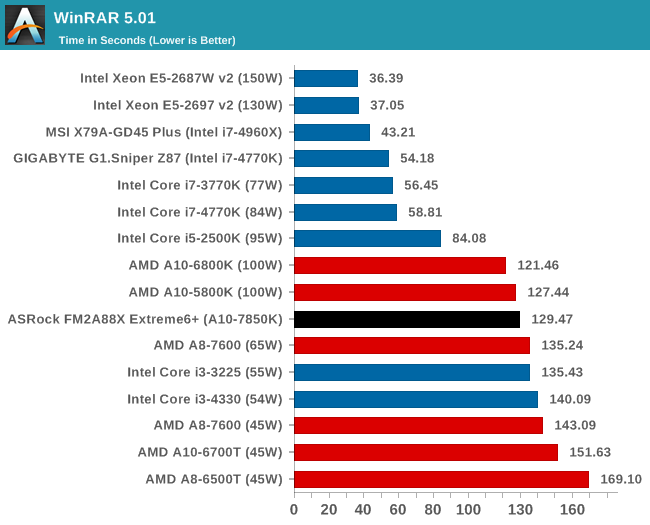
Image Manipulation – FastStone Image Viewer 4.9: link
Similarly to WinRAR, the FastStone test us updated for 2014 to the latest version. FastStone is the program I use to perform quick or bulk actions on images, such as resizing, adjusting for color and cropping. In our test we take a series of 170 images in various sizes and formats and convert them all into 640x480 .gif files, maintaining the aspect ratio. FastStone does not use multithreading for this test, and thus single threaded performance is often the winner.
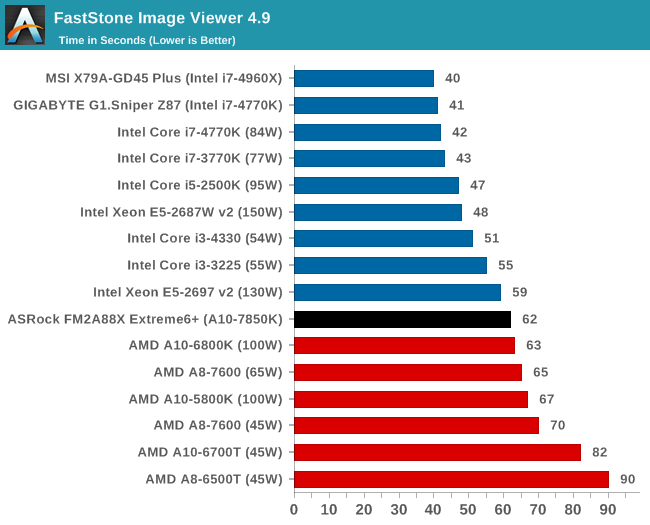
Video Conversion – Xilisoft Video Converter 7: link
The XVC test I normally do is updated to the full version of the software, and this time a different test as well. Here we take two different videos: a double UHD (3840x4320) clip of 10 minutes and a 640x266 DVD rip of a 2h20 film and convert both to iPod suitable formats. The reasoning here is simple – when frames are small enough to fit into memory, the algorithm has more chance to apply work between threads and process the video quicker. Results shown are in seconds and time taken to encode.

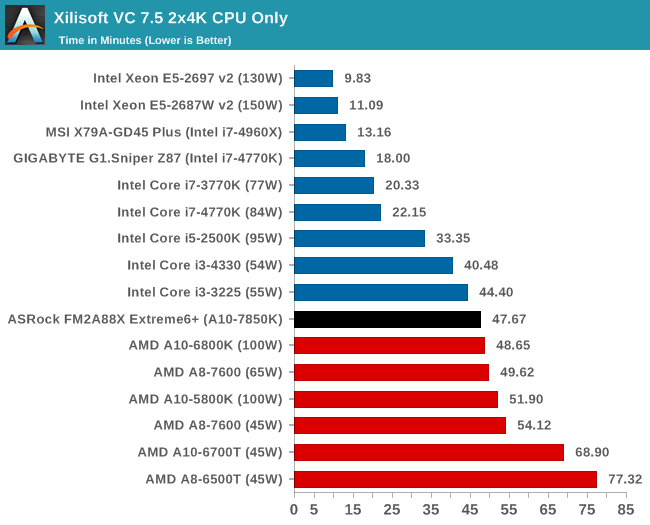
Video Conversion – Handbrake v0.9.9: link
Handbrake is a media conversion tool that was initially designed to help DVD ISOs and Video CDs into more common video formats. The principle today is still the same, primarily as an output for H.264 + AAC/MP3 audio within an MKV container. In our test we use the same videos as in the Xilisoft test, and results are given in frames per second.
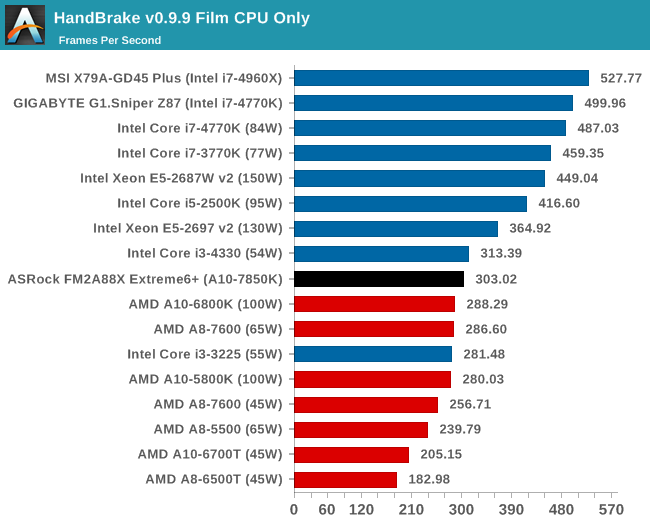
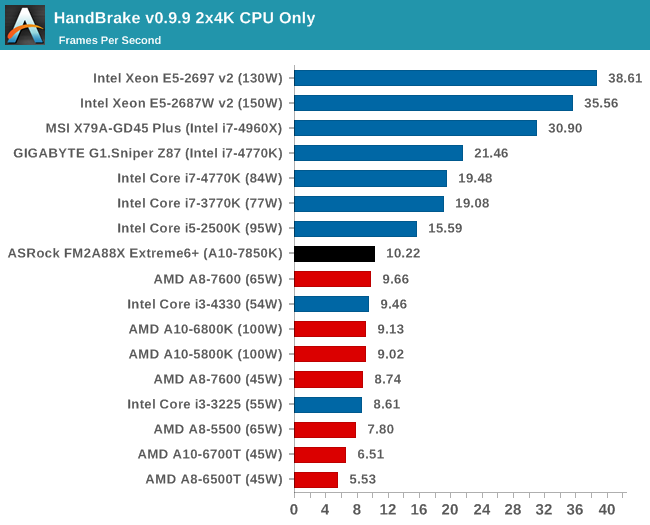
Rendering – PovRay 3.7: link
The Persistence of Vision RayTracer, or PovRay, is a freeware package for as the name suggests, ray tracing. It is a pure renderer, rather than modeling software, but the latest beta version contains a handy benchmark for stressing all processing threads on a platform. We have been using this test in motherboard reviews to test memory stability at various CPU speeds to good effect – if it passes the test, the IMC in the CPU is stable for a given CPU speed. As a CPU test, it runs for approximately 2-3 minutes on high end platforms.
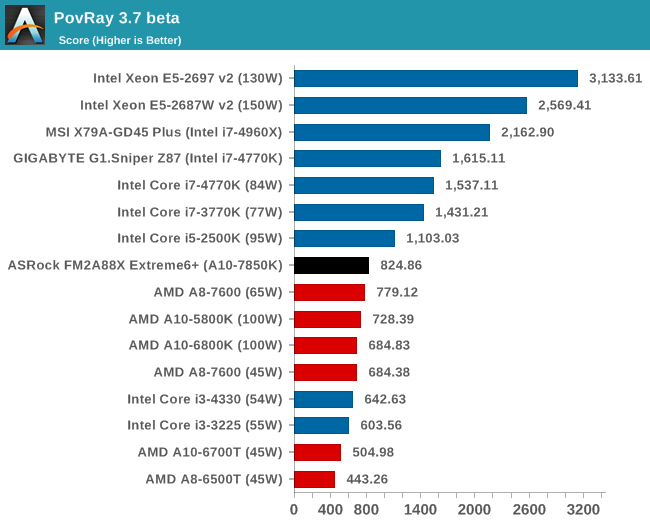










44 Comments
View All Comments
niva - Wednesday, March 19, 2014 - link
These benchmarks are making me depressed for AMD CPUs. I guess it's time to switch to Intel after not having purchased an Intel chip since 1996.nathanddrews - Wednesday, March 19, 2014 - link
Come on in, the water's fine.Malorcus - Wednesday, March 19, 2014 - link
I hear you man, I did the same with my current Ive Bridge CPU. I am looking to build a media computer using an AMD APU though. They still have their niche, but it is not in high end computing/gaming.ddriver - Wednesday, March 19, 2014 - link
You'd be surprised by the amount of needed and commercially viable tasks for which those poor CPUs are more than fast enough. It is a sad thing to see AMD struggling to compete with Intel's value products.Fallen Kell - Thursday, March 20, 2014 - link
AMD has sadly not had a real competing product in the high end side for 6 or 7 years now. On the low end, AMD was competing, until Intel decided to compete in this market segment. The last two updates that Intel has made were more focused on the lower end than on the high end. This is finally cutting into the one thing keeping AMD alive. I really hope AMD does survive because those of us that are old enough to remember know that Intel hates the consumer and only really pushes technology when it is competing. We would have CPU's that are only soldered directly into motherboards with no ability to upgrade, completely locked down CPUs with no ability to overclock, locked in memory bus speeds that are tiered based on the CPU/motherboard that you purchased with higher performance memory compatibility costing you extra, etc., etc....But I really don't see a way that AMD can compete at this point. They are still hemorrhaging money (not nearly as bad as a year ago when they lost $1.2 BILLION, but even after restructuring to cut 31% of their operating costs, they still lost $162 million last year). While I understood the reason for acquiring ATI, I believe ATI is worse off due to that acquisition. ATI went from being a profitable company competing well in their market, to one that is losing money and is seemingly almost a generation behind Nvidia in their offerings (I say this based on the fact that the brand new released top of the line AMD graphics cards can barely beat the last generation of cards from Nvidia in performance and can not come anywhere near the Nvidia offerings in power/performance or heat/performance, and Nvidia is getting ready to release its true next generation of cards even while they simply released the last generation of cards at their full potential to beat AMD's current cards now that AMD finally had a competing product). The major losses that AMD as a whole has, is taking its toll on the R&D AMD can afford to do in terms of increasing the efficiency of their designed with respect to power and cooling requirements while still being able to push the performance of their cards.
Demiurge - Friday, March 21, 2014 - link
Funny, I thought the same thing about Intel CPU's when GPU's started to encroach on the high performance features such as physics, ray-tracing, signal processing, and other high intensity applications. There's a bigger picture that I think a lot of people miss. The market has already shifted away from CPU's being the centerpiece of high performance applications. AMD has the right strategy with buying ATI and the paradigm of Heterogeneous Computing, but like Intel with the P4: it's too little too late. If they had the software, they might've been able to pull this off, but that is exactly what they are trying to do with Mantle. I think only unanimous adoption would've guaranteed a win. It was a big risk, and it would have been an amazing upstart, but I don't think it will pay off as much as they need it to. Just a modest opinion... and so a long rant ends... ;-)pandemonium - Thursday, March 20, 2014 - link
AMD hasn't been competitive to Intel for the consumer since 1999 or so? They've always been cheaper, and always been far lower in gaming and general desktop usage results as well. You are very, very, very late to the party, lol.mr_tawan - Thursday, March 20, 2014 - link
I believe it was Intel Core series (2006) that started to get ahead of AMD's CPU. Before that, AMD CPUs was both perform better and cheaper. Intel CPUs were power hungry and expensive while did not yield excellent performance.The raw ALU performance on the current line of AMD CPU is quite low because of the design decision to reduce the space occupied by the CPU while add even more GPU on the die, and then make them work together more nicely. It's the direction the AMD heads to.
I believe that one day even the FX line would be APU just like those A-series.
Vinny DePaul - Thursday, March 20, 2014 - link
I feel your pain. I am an AMD fan. I want to keep using AMD but the CPU is running too hot. It is heating up the room! I switch to Intel. It is just easier.... I hope the AMD's involvement in PS4 and Xbox One will shape the future in games and software.Xpl1c1t - Thursday, March 20, 2014 - link
This is exactly what I did going from a Athlon XP Palomino, to Athlon 64 Venice, to a Core i5 Lynnfield.I'd consider purchasing an AMD processor again if the whole APU thing becomes quite competent and powerful at a smaller and more efficient node. I'd promptly and gladly buy an APU with the equivalent of 2 IVB cores and a 7870 onboard if it could me mounted on a Pico-ITX board...